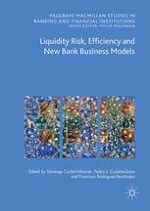2016 | OriginalPaper | Chapter
3. Basel III, Liquidity Risk and Regulatory Arbitrage
Authors : Viktor Elliot, Ted Lindblom
Published in: Liquidity Risk, Efficiency and New Bank Business Models
Publisher: Springer International Publishing
Activate our intelligent search to find suitable subject content or patents.
Select sections of text to find matching patents with Artificial Intelligence. powered by
Select sections of text to find additional relevant content using AI-assisted search. powered by
